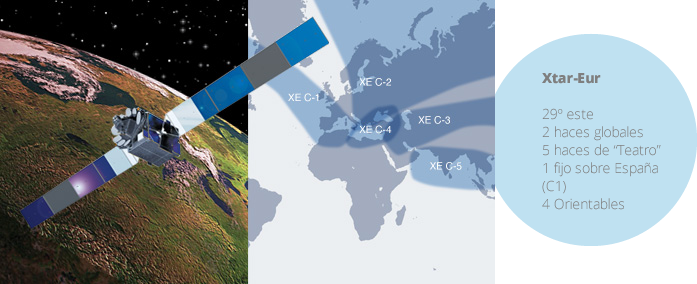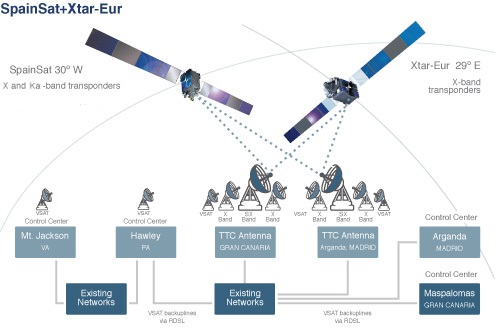Xtar-Eur
Positioned at 29º east, it offers coverage from Brazil to Indonesia, including Europe, Africa, the Middle East and much of Asia. This satellite has two control centers, one in Ottawa (Canada) and the other in Mt. Jackson (Virginia, USA). Due to the satellite’s orbital position, its tracking stations are located in Spain (Arganda and Maspalomas).

Xtar-Eur
Positioned at 29º east, it offers coverage from Brazil to Indonesia, including Europe, Africa, the Middle East and much of Asia. This satellite has two control centers, one in Ottawa (Canada) and the other in Mt. Jackson (Virginia, USA). Due to the satellite’s orbital position, its tracking stations are located in Spain (Arganda and Maspalomas).
The platforms of the two Hisdesat satellites, SpainSat and XTAR-EUR, are based on the Space Systems/Loral LS-1300 model, with 3-axis stabilization. This system’s efficiency and reliability has been demonstrated on numerous missions. Satellites manufactured by SS/L have delivered in excess of 1,100 years of on-orbit service.
Both satellites were designed to provide service over a 15-year operational lifetime, and the antennas onboard were configured to allow for a combination of beams, both fixed and steerable, thus maximizing the system’s flexibility. The steerable beams can be aimed anywhere within each satellite’s coverage range and can be aimed over a specific area at any given time. In addition, several transponders can be used by the same beam.
Each satellite can provide 1,000-MHz of bandwidth in dual polarization, both left and right, thus optimizing the use of the available spectrum.
SpainSat
SpainSat was placed in orbit at 30º west on March 11, 2006 by an Ariane 5 rocket. Its launch weight was in excess of 3,700 kg. It has several high-power X- and Ka-band transponders.
It has two global, one fixed and three steerable beams, though the latter can be aimed over a specific area.
Xtar-Eur
XTAR-EUR was placed in orbit at 29º east on February 12, 2005 by an Ariane 5 ECA. Its launch weight was in excess of 3,600 kg. It has high-power X-band transponders.
Like SpainSat, it has two global, one fixed and four steerable beams, though the latter can be aimed over a specific area.
